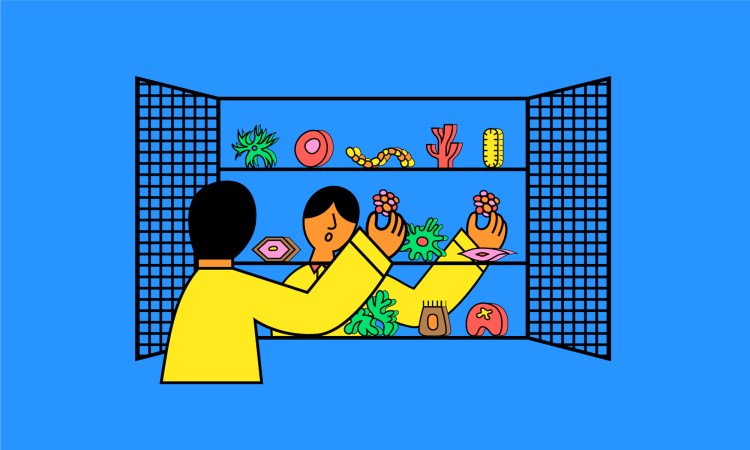
Cultivate a healthy appreciation for yourself — and all people — by tripping out on the wonders of the human body, suggests science communicator Samantha Yammine.
This post is part of TED’s “How to Be a Better Human” series, each of which contains a piece of helpful advice from someone in the TED community. To see all the posts, go here.
Most of us have had those fleeting moments when we become acutely aware of the wonder, strangeness, and ingenuity of the bodies we live in. We catch ourselves pondering questions like “How does my heart keep beating?” and “How can I shed so much hair in the shower yet still have so many left on my head?” and “Where exactly in my brain are the thoughts that I think located?”
Canadian science communicator and neurobiology PhD candidate Samantha Yammine suggests that we encourage these feelings of astonishment and curiosity. In fact, we might even want to ask the “What am I !?” question a little more often.
In Yammine’s personal experience, that query has served her well. She says, “I’m glad I asked what I am because it’s a pretty cool answer” — one that’s granted her a fresh perspective and led to her career in science.
So, what exactly are we? While poet Walt Whitman was probably not referring to our cellular makeup when he wrote “I am large, I contain multitudes,” he was spot-on. The average human body is estimated to contain a whopping 37.2 trillion cells. But this number doesn’t even include the 39 trillion bacteria in the human microbiome, or the many bacteriophages we host that aim to infect them.
These 37.2 trillion cells represent more than 200 different cell types that range dramatically in size, shape and function. “Just look at your body,” says Yammine. “You have skin, you have hair. You can imagine your muscles, you can feel your pulse” — all of it, “your brain, your fat — you’re made of all of these beautiful different pieces, all of these cells.”
Just how is it that they’re able to perform so many specialized activities and tasks? Although all the cells in your body contain roughly the same DNA, the genetic code is expressed differently depending on the cell. “Each one is only using a subsection of DNA and so each cell ends up a little bit different,” Yammine says. This is because “they’re using that DNA to make different molecules, different proteins, so each cell has a different combination of stuff inside.” Different cells can thus form tissues and organs, receive and transmit signals, and protect our bodies from pathogens.
Even as we continue to live and breathe, the cycle of life-and-death is occurring inside us. Some cells — the cells that form our heart muscles, the brain cells in our cerebral cortex, and the cells in the inner lenses of our eyes — generally stay alive for the duration of our lives. These, however, are the exceptions.
Turnover is constantly taking place, as cells die — undergoing a sacrificial, programmed death called apoptosis once they’re no longer needed — and new cells are born all the time. For example, the cells that make up our epidermis, the outer layer of our skin, live just about 2 to 4 weeks before they fall off, get replaced, and become dust. Enterocytes, intestinal cells responsible for the absorption of essential compounds, exist for around four days, making them our shortest-lived cells.
But oh, what feats these cells perform during their lifespans. Every day, your kidneys filter about 48 gallons, or 180 liters, of fluids and your heart pumps some 2,000 gallons, or 7,600 liters, of blood. As Yammine says, “all these little cells [are] working so hard for everything we think and do and say to one another without us even realizing that they’re doing it.”
They allow you to see, breathe, eat, hear, think, communicate, love, and they shape how you perceive and interact with the world around you. Every single movement you make is the result of an intricate collaboration among many different specialized cells. Now this is something worth taking the time to appreciate: the tireless, precisely coordinated, behind-the-scenes machinations of the cells in our bodies.
And look around — this process is happening in everyone you know (and everyone you don’t know). Yammine says, “Seeing all of these cells and all of these things that we’re made up of has made me more compassionate for myself and for others because it makes me realize that there’s so much going on inside each of us.”
Reminding ourcell-ves of the intrinsic beauty of our bodies highlights the blend of sameness and diversity that comprises each of us. Yammine says, “So often we reduce someone to one thing: we reduce someone to a stereotype, an object, their race, their gender … and we’re not one thing. We’re many trillions of things.”
So, next time you want to pay someone special a compliment, just tell them — as Yammine puts it — “According to science, you are a magnificent molecular masterpiece.”
Want to find out what causes baldness? Or how wounds heal? Learn the answers to these questions — and absorb other fascinating findings about the human body — through TED-Ed lessons.
Watch Samantha Yammine’s TEDxDownsviewWomen talk here:












